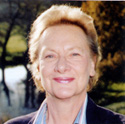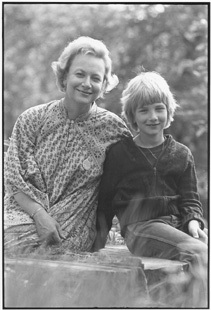
"If you happen to get hit by a bus,
don't forget to throw my manuscript
clear!"
Nicola opposite enjoying
a lovely afternoon with her son Stefan
in Regent's Park, London, taken in 1977
when
Return to Wuthering
Heights
was published
|
Meet Nicola Thorne
interviewed by Patrick
Lavender
Nicola Thorne started her writing
career shortly after leaving the London School
of Economics, from which she graduated in
sociology, and her first six attempts were
contemporary autobiographical fiction, which in
her own words, 'were somewhat heavy'.
She smiles when she recounts how
in those early days she would send her then
secretary to the various publishers with the
instructions 'If you happen to get hit by a
bus, don't forget to throw my manuscript clear!'
But all the effort was in vain and none were
published. She remembers finally packing them up
in black bin bags and, somewhat sadly, watching
them been loaded up and driven away in the
dustcart. In retrospect ,however, she thinks a
lot of first time writers might consider doing
the same thing.
Then, having been taken on by
leading agents Curtis Brown, Nicola wrote a
thriller Inclination to Murder,
under her real name Rosemary Ellerbeck and
achieved her first success with Hodder &
Stoughton Publishers. Two further novels,
however, failed to tempt them.
Next came the highly successful
and for the times, mid sixties, controversial
novel The Girls under the name of
Nicola Thorne. 'My agent suggested that I
change my name for this very different type of
book. 'Thorne' was my grandmother's name and
'Nicola' happened to be a song played on the
radio at that time. The Girls went into
paperback and I thought that I was going to be
rich and famous', she recalls. But that was
not to be. The Girls had shocked
the head of the firm and despite writing another
novel that her editor considered to be
'terrific', publisher Heinemann turned its
back on her (this was the novel found in a
garage many years later and published as
The Little Flowers
in 2004!)
|
'It was a terrible blow after
such a success and I found myself having to
rebuild my writing career'
Nicola then had several exciting
years in publishing as Editorial Director of
Milton House Books, but decided that writing
original paperback fiction was an area to get
into.
'I wrote a series of three books
about a gypsy in the Lake District called The
Enchantress, under the name of Katherine
Yorke. The idea at that time was that you might
have different pseudonyms for different types of
novels and indeed different publishers. I would
never agree to that now.'
|
 |
Never far from controversy, in
1977 Nicola started the trend of writing sequels
to the classics with Return to Wuthering
Heights. Whilst she was vilified by the
Brontė Society and ridiculed by certain sectors
of the press, the book was a great success! and
was published worldwide.
'In 1980 I was given carte
blanche by my new publishers Granada to write a
book about women in the 19th century and this
was The Daughters of the House - my first
really big book'.
But rather than asking her to
write a sequel, she was commissioned to write a
book about the cashmere industry. Where the
Rivers Meet was published in 1982 and became
Nicola's first book to hit the Bestseller List.
Its striking cover was designed by Nigel
Chamberlain who did many others for her. She has
the artwork hanging on the walls of her Devon
home. Nicola then started the much acclaimed
Askham Chronicles consisting of four books
covering the period 1898 to 1967, which took
her four years to write and which were reprinted
several times.
In 1987 I really thought that my
chance of fame and fortune had arrived at
last. My agent phoned me to say that Booker Plc,
who ran the Booker Prize, wanted to commission a
book about champagne, which was then to be made
into a film or TV series. I was given an outline
of a story to follow - a French equivalent of
Dynasty - and whilst my books Champagne
and Champagne Gold did very well, the
promised TV series never materialised. I still
don't know why to this day. The project took up
another four years of my life and was a lot of
hassle. Too many people were involved and,
although the author, I was sidelined and
ultimately left in the dark as a sort of
unimportant accessory. Altogether it was not a
happy experience, though it had a few perks
including trips to Reims and much consumption of that delicious beverage! I then came to
Dorset in 1989 and began writing The People
of this Parish, the first of six books set
in Dorset. The sixth and final book in this
saga, In Time of War was published in
Autumn 2000.
Of the 30,000 plus authors
registered under the Government's Public Lending
Right Scheme, she has been among its top band
of novelists most borrowed in public libraries
for over a dozen years, and her books have been
translated into many languages, including
Polish, Dutch, Spanish, Italian and Japanese.
In June 2000, she was the subject
of an HTV documentary, filmed by Dashwood
Productions Ltd, In Search of Martha. The
Novel My Name is Martha Brown aroused
considerable interest. Based upon a true story,
the book is about the last woman publicly hanged
in Dorchester in 1856, a scene witnessed by the
young Thomas Hardy.
Since the year 2000 she has
written a brand new saga set in Dorset. The
first was The Broken Bough to be followed
by The Blackbird's Song, The Water's
Edge and Oh Happy
Day!
At the end of the year 2002
Nicola was involved in a serious road accident
which took a long time to recover from and
not only prevented her from writing for a
number of years, but was virtually the end of
her prolific writing career.
However having eventually made
a remarkable recovery from her accident, Nicola
felt she wanted to use the experience, because
the way such an event changes people's lives
intrigued her as a novelist, but she was anxious
that it should not be considered an
autobiography. Despite the theme, it is not a
grim story, but is in fact a novel about
relationships, particularly between Eleanor, the
central character in the novel, and her daughter
Alex who reluctantly comes to look after her.
On a Day Like Today, was published in
hardback in June 2008 with a paperback and audio
in 2009. Then came the The Holly Tree,
published in July 2010,about the fortunes and
interaction a group of characters attending a watercolour class
Her latest novel, published in
June 2012, After the Rain is one she
always wanted to write. It is based very loosely
on the life of her mother who was born in New
Zealand but died, comparatively young, in England as the result of an accident .Although a
charismatic, attractive and accomplished woman,
she was always very secretive about her early
life. Nicola always regrets she had never asked
her mother more about her life in New Zealand.
However with the help of New Zealand cousins,
who did a lot of research into family history,
she has attempted a largely speculative account
of what that might have been, while
acknowledging that, except for one or two known facts, it is almost all conjecture.
To complete her recovery Nicola
moved to Plymouth, Devon in 2005 to be near her
son Stefan, her daughter-in-law Rebecca and
their two wonderful young children Tom and
Molly. At the time of writing they have gone to
live in Doha, Qatar where Stefan is pursuing his
career as a broadcast journalist with the
acclaimed Television network Al Jazeera English.
As well as planning a sequel to After the
Rain Nicola is also pursuing a new
interest, putting much of her huge backlist
(over 50 novels) as E books onto Amazon Kindle
in order to give part of her lifes work, now
out of print, a new lease of life..
|